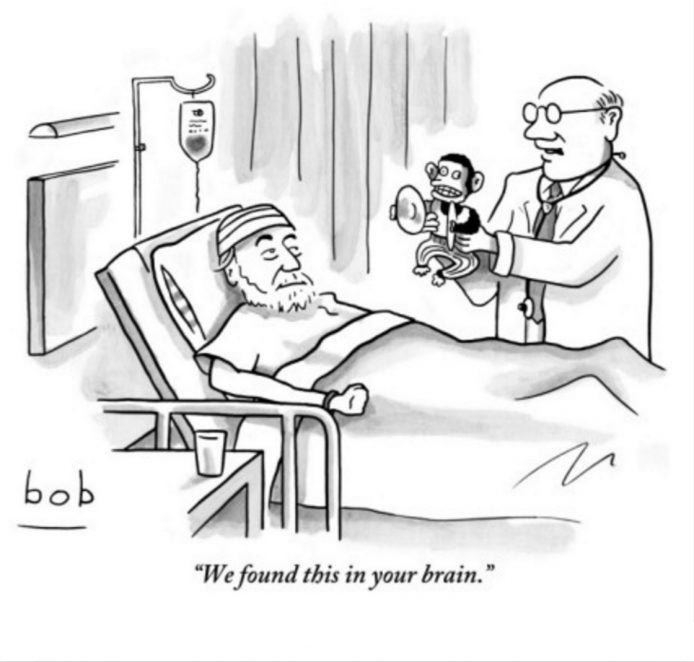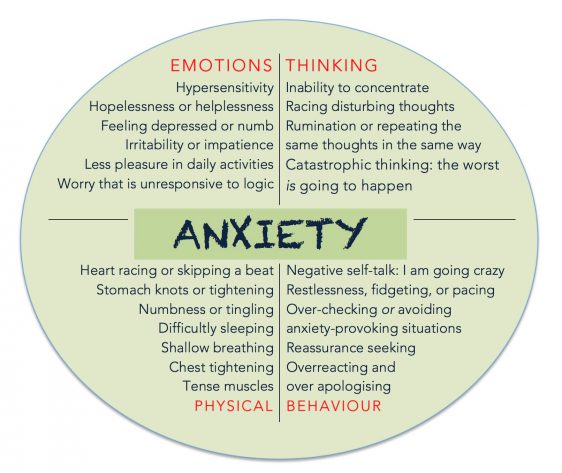PSYCHOLOGY OF US
YOUR RESOURCE LIBRARY
ANXIETY

I am a person who feels guilty for crimes I have not committed.. The police search the train station for a criminal at large* and I cover my face with a newspaper, wondering if maybe I did it in my sleep. The last thing I stole was an eight-track tape, but to this day I’m unable to enter a store without feeling like a shoplifter. It’s all the anxiety with none of the free stuff. -David Sedaris
Contents:
What is Anxiety?
Everyday Anxiety
Unhealthy Anxiety and Anxiety Disorders
How Psychotherapy (and Monkey therapy) Helps You Address Your Anxiety
What is Anxiety?
Anxiety is the uneasiness that alerts us to risk of danger, loss, or failure, which can be either real or imagined. When we are anxious, we focus on negative things that might happen. Anxiety can be an unrealistic or disproportionate focus on common situations (driving on freeways, doctor visits, or confronting a partner) or it can be a reasonable and rational response to a situation (possible or likely threats of war, job loss, and health issues).
Whereas anxiety is caused by imagining threats, fear is the response to a specific threat that is present or imminent. However, our brains have difficulty telling the difference between real and imagined threats. As a result, our brains process future-focused anxiety and real-time fear with similar neurochemical and physical responses. In other words, anxiety is a future-focused fear response.
Most information online refers to anxiety in terms of its dysfunction. For example, David Sedaris, in the excerpt above, refers to his experience of what psychologists call generalised anxiety or a fear response that is triggered by just about every situation (1). However, anxiety can be a normal and healthy part of our emotional life. It motivates us to prepare for the future. For example, thinking about possibly failing an upcoming test triggers a fear response in the brain, prompting us to study.
Everyday Anxiety
I am an old man and have known a great many troubles, but most of them never happened. -Mark Twain
Signs and Symptoms of Everyday Anxiety
Anxiety is not always easy to recognise. It can come from out of nowhere, without explanation. We may not notice our body sensations or we may not recognise that our body sensations are due to anxiety.

Causes of Everyday Anxiety
We all have worried about our jobs, our relationships, and our safety at some time in our lives. Anxiety is caused by our imagination working to protect us (and our loved ones) from potential threats, whether or not the threats are likely to happen. Anxiety is often a healthy and functional response to our situation. The problems arise when our anxiety runs away with us. Unfortunately, this is a common occurrence. But it is not our fault.
We feel overly anxious, in part, because our brains are hardwired with a negativity bias.
Our ancestors did not have to be happy to survive but they did need to be vigilant. Cavemen who were complacent about hunting, reproducing, and protecting themselves did not survive long enough to become our ancestors. So, our brains evolved to protect us from life or death situations. Unfortunately for us, our archaic brains still operate as if we live amongst immediate danger. For example, we are more likely to fear snakes than automobiles, even though the latter causes more casualties in modern society.

Worry is a protective reflex. When there is any kind of uncertainty, our brains automatically over-compensate with anxiety to keep us safe.
Anxiety gets bad press
Contrary to what most anxiety literature says, anxiety can actually be helpful. Anxiety is our brain’s way of motivating us to plan, prepare, and problem solve. From mild anxiety to intense anxious feelings, all levels of can be useful.
How Anxiety Helps Us
Mild anxiety occurs when we imagine what might go wrong. It triggers our brain and body to prepare for any upcoming challenges. For example, professional athletes might not call it anxiety but their physiological responses are the same. Their raised heart rates, heightened arousal, narrowed focus, and tense muscles all prepare them for peak performance.
When we are moderately nervous, we may experience a knot in our stomach, restlessness, or inability to concentrate on anything else. These sensations mean that our brain is vamping up for a challenge – releasing stress hormones such as cortisol and adrenaline – to increase focus and energy for the task at hand. For example, we may enjoy (or even be addicted to) the feelings that we get from excessive gambling, but our worries about amassing debt motivate us to stop or to seek help instead.
Even intense anxiety can be useful. When we are in high-arousal survival mode, our brain releases bursts of energy to escape imminent danger. In an abusive relationship, anxiety about future abuse can give us the courage, focus, and strength to find a way out.
Unhealthy Anxiety and Anxiety Disorders
We will never be completely free from anxiety nor would we want to be. Anxiety helps fulfill our basic need for safety and protection. But anxiety must be balanced with our other basic needs: rest, resources (food, shelter), and bonding with others (2).
Prolonged anxiety interferes with our wellbeing and can erode our physical and mental health over time. The more anxious thoughts we have, the more we train our brains to think anxious thoughts. Prolonged and excessive anxiety can intensify into anxiety disorders if it goes unchecked.

When Anxiety Becomes an Anxiety Disorder
Unhealthy anxiety becomes an anxiety disorder when our worry becomes relentless, unrealistic, disproportionate, and unresponsive to logic. Anxiety interferes with your ability to fulfill responsibilities and interrupts daily life (for example, if you can’t leave the house, are struggling at work, or avoiding your normal activities). If you experience excessive worry more days than not, for at least six months, you may be suffering from an anxiety disorder.
Panic attacks. One sign of an anxiety disorder is the onset of the fear response that seems to come from out of nowhere. In the absence of real danger, we focus excessively on our intense physical sensations such as racing heart, shortness of breath, and dizziness. Our heightened awareness of these symptoms causes our fear to intensify (for example, we might think that we are having a heart attack). As a result, a self-perpetuating panic cycle occurs.
Relentless negative thought patterns. Ruminating – getting caught in the same anxious thought patterns – results in habitual thinking patterns that become increasing harder to change. For example:
Worry: Did I lock the doors?
Negative interpretations: I am worried about it so I must not have locked them.
Ruminations: Did I lock the doors? Did I lock the doors? Did I lock the doors?
Obsessions: Did I lock the doors? I didn’t lock the doors. I’ll just check again. Yep. Wait, did I really lock the doors? I know I did.. I think. But did I lock the doors? I think I did but I can’t stand this anxiety. I have to make absolutely sure that I did lock the doors. I’ll just check again.
Habitual Hypersensitivity. Excessive and relentless worry can lead to hypervigilance, hypersensitivity, and scanning for signs of threat. Over time, these safety strategies become habitual as well and can result in frequent agitation, irritability, or dread.
There are many forms of anxiety disorders including fear of having fear responses (panic disorders). With anxiety disorders, the fear stimuli may be different but the underlying fear mechanisms are the same.
Causes of Anxiety Disorders
This is the trouble with origin hunting. There are so many origins. -Daniel Smith
Trauma expert Bessel van der Kolk points out that no one knows for sure what causes anxiety disorders. Research has shown that some people are more prone to anxiety than others. However, evidence shows that genetic predisposition is only a tendency (3). Environment also plays a large role in bringing these out.
Parents with anxiety issues can pass this anxiety on to their children. Abusive or neglectful family environments or traumatic events (natural disasters, war, or severe and/ongoing abuse) which teach children that the world is unsafe or that others are dangerous can lead to anxiety disorders later in life.
Not all anxiety disorders arise from psychological issues. Van der Kolk states that ‘..there are some physical conditions that make people act like they are having panic attacks or anxiety. Among these are hypoglycemia, hypothyroidism, hyperthyroidism, a mitral valve prolapse, inner ear problems, congestive heart failure, deficiencies of certain minerals and vitamins, withdrawal (like nicotine withdrawal), and PMS’ (3). It is worthwhile to check with your General Practitioner for medical conditions.
FIND OUT MORE: How Monkey therapy Can Help You Alleviate Anxiety, The Science Behind Anxiety, Steps You Can Take Now to Alleviate Anxiety.
References and Contributors
- David Sedaris. (2004). Dress Your Family in Corduroy and Denim. *’Criminal at large’ is reworded.Paul Gilbert. (2010). The Compassionate Mind.
- Bessel van der Kolk. (2014). The Body Keeps the Score: Brain, Mind, and Body in the Healing of Trauma.
- Rick Hanson. (2013). Hardwiring Happiness. The New Brain Science of Contentment, Calm and Confidence.
- Catherine Pittman & Elizabeth Karle. (2015). Rewire Your Anxious Brain: How to Use the Neuroscience of Fear to End Anxiety, Panic, and Worry.
How therapy works
Worksheets and useful information
Creative Process
Feeling Stuck
Stress
Depression
Feeling Down
Anxiety
Guilt and shame
Find out more
What I do differently
Monkey Therapy
Transformational Coaching
Online Therapy
Trauma
Your inner critic
The science behind it
Steps you can take now
Publications
More than CBT
More than IFS
Psychedelics
Neurodiversity
Thank you!
Your message has been sent. We'll contact you shortly
© 2023 The Monkey Therapist. All Rights Reserved. Site Designed By Samantha Ósk
PRIVACY POLICY